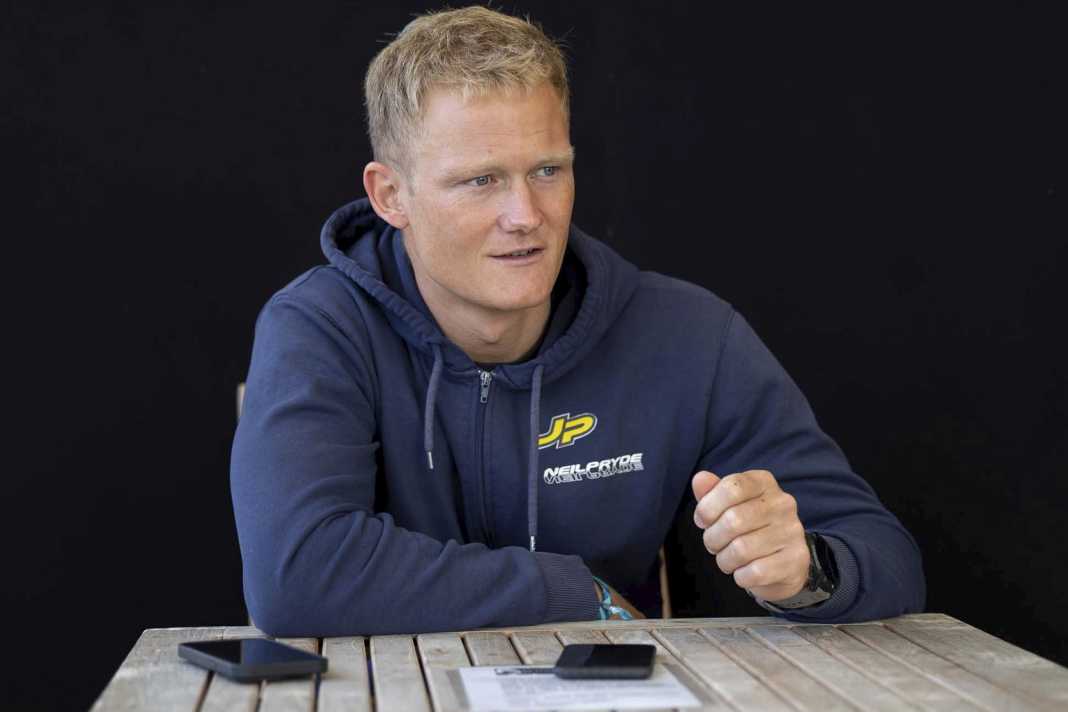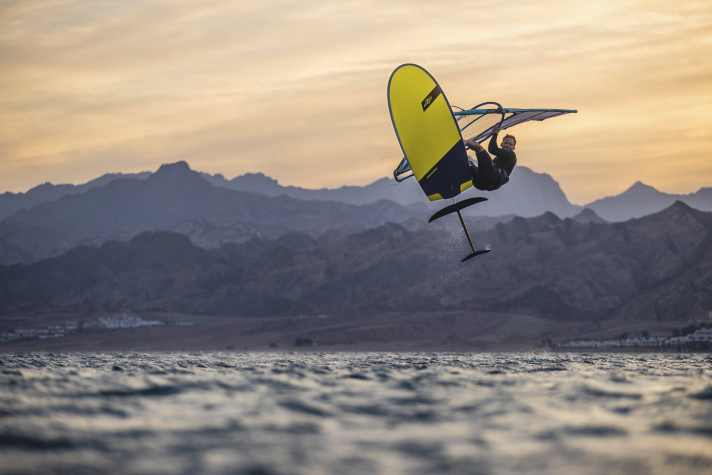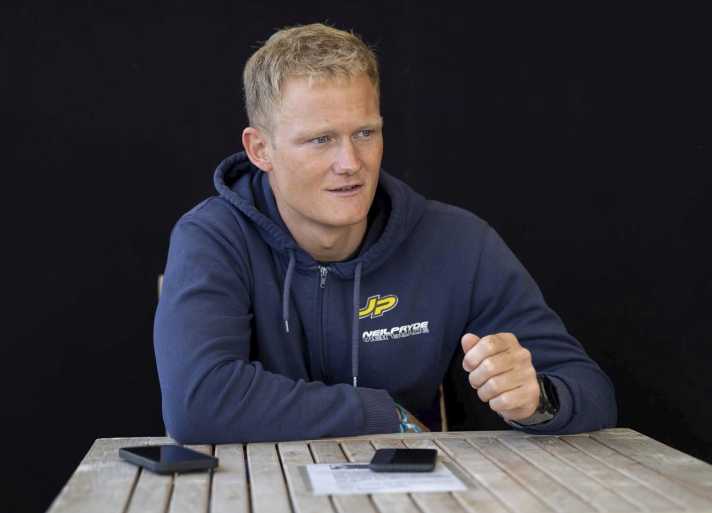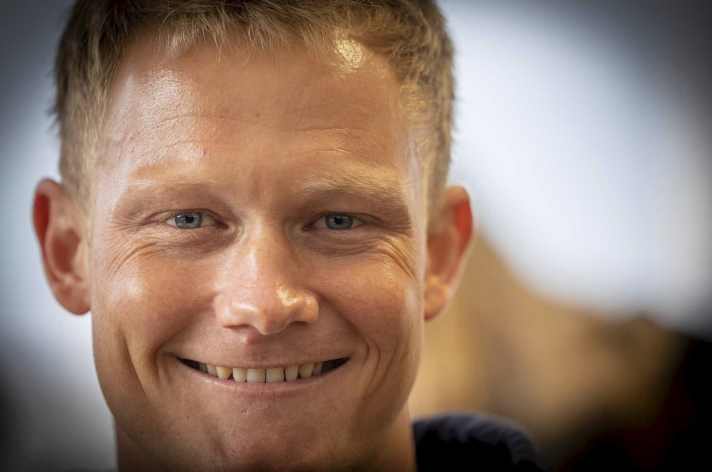





Could there be a better job than being a test rider for one of the big windsurfing brands? You get to test the latest and greatest equipment all the time and put it through its paces all year round in a first-class surfing area. A fantastic idea, isn't it? But of course the real life of a head tester at a sailing brand looks a little different. We spoke to Sebastian Kornum, who tests NeilPryde sails for sailmaker Robert Stroj, and Phillipe Vigneron, who supports Renato Morlotti in the development of the Gun sails, about their "tough" day-to-day work.
Sebastian Kornum - Sail tester for NeilPryde
Sebastian Kornum comes from a Danish windsurfing family, has been surfing regattas since a young age and is a permanent fixture in the World Cup. Size is meant more in a figurative sense, as he is rather small for a slalom racer.

How is it possible to be so successful with your less than ideal physical conditions? Was it the basis for being the head sail tester for your sponsor NeilPryde?
Yes, the knowledge of my equipment, efficient testing, being able to successfully tune this equipment and experience in product development give me the advantage. On the water, I quickly feel differences in equipment and trim, however small they may be, and I recognise them within just a few minutes. And, yes, I have good skills that work well on the regatta course and that I have also acquired through my work at NeilPryde.
Just "good skills"? The adjective "excellent" is probably better, isn't it?
Okay, yes. As a small and light slalom pro, I always have to focus on the smallest details in order to be able to celebrate success at this high World Cup level. And nowadays, even the heavy guys stay in the foils after the jibes, which has made it even harder for me.
How did you get the job of chief sail tester at NeilPryde on Maui?
I had already taken part in regattas at a young age and had always given my sponsors JP Australia and NeilPryde experience about my equipment. They knew that I had a good feeling for my equipment. After my success in the summer of 2012 at the Formula World Championship, where I surprisingly came seventh, NeilPryde sail designer Robert Stroj gave me the opportunity to test all the sail lines for him on the water over the winter.

What were the beginnings like?
I arrived on Maui in November 2012 and immediately started testing prototypes with Pieter Bijl. These were all sail lines, from race-orientated lines to wave sails. I learnt so much about the sails, it pushed me so much that I was already travelling much faster the following year. And the next winter I was the chief sail tester.
Although other team riders are also actively involved in the sailing tests at NeilPryde, aren't they?
Yes, for example, Antoine Albeau, Mateus Isaac and Arnon Dagan were involved in the winter for the race tests and Robby Swift and Jason Polakow were involved for the wave sails.
"Testing" - is the drive behind this to make sails better and better and to achieve "the best"?
Basically, I want to improve in all areas of life. And the more sails I was able to test on Maui, the more confident I became over time and the more responsibility I was given by Robert Stroj. Everyone looks up to Robert, he is the best and most successful sail designer, and I was just happy to be able to work closely with him on Maui.
What did a normal working day on Maui look like?
We set off from Kahului harbour at six o'clock in the morning to test formula sails, which means that we tested the 10, 11 and 12-power sails this early in the day for perhaps two hours, as this is the only time when the wind is still light. Back on the beach, we call Robert Stroj to give him the test results - "fresh feelings" - straight away, which is so important because we need to be able to communicate the impressions we have just gained on the water immediately. I also describe the things I would like to have changed on the sail. And only then do I send Robert the results in an e-mail.
Robert often asks us to bring the sails directly to the sail loft so that he can make a "re-cut" so that small changes can be made to the existing prototype in the workshop, such as changing the luff curve. The "new" sail is tested again the very next day.
How long does this entire process take?
We continue to develop and invest in further prototypes and re-cuts for as long as we see further potential. There are no compromises at all with Robert.
How many prototypes and re-cuts are there per sail size?
That's up to six prototypes per size with up to three re-cuts. As I said, Robert doesn't make any compromises. Every single size is developed and a perfectly functioning 6.2 metre sail is not simply projected onto 6.7 square metres. The knowledge gained is simply "transferred" to another sail size. And it's not just sails that are invested in, but also an infinite number of hours.

Aren't the files with the data of a sail simply sent to Asia for production and days later you receive exactly this sail on Maui?
No, the prototypes are usually sewn directly by Lovisa, the seamstress, in the sail loft half an hour's drive from the beach, which works much faster because a wave sail prototype can be tested on the water the very next day, whereas sewing a slalom sail takes around three days. In contrast, a sail prototype sewn in Asia takes around six days due to longer delivery routes!
However, files with the final cuts are sent to Asia so that we can get them back as final prototypes and subject them to a final check on the water to see whether everything has turned out as it should.
And how many prototypes, including re-cuts, have you had in your hands during your years as a tester?
I remember that I had to fill a large van with prototypes only, which was far more than 50 sails from floor to ceiling. But how many were there in total? No chance of counting them - lots!
Did you always get the same impressions during the sailing tests?
Yes, most of the time the impressions are exactly the same. Only rarely do they diverge. There were also two formula sails that were really good. The first sail was a little faster and was the favourite of my test partner Gabriel Browne and the second sail was a little better on the cross, which was my choice. We then worked on these sails for weeks.
On the water, you get what you call "fresh feelings" from the prototypes. You have to speak a common "language" with your test partner and sail designer, i.e. articulate your experiences in the same way so that they are understood by the other person in exactly the same way as you meant them.
Yes, communication plays such an important role and it takes time until you can communicate perfectly with your test partner and Robert and have achieved this common "language" to express these things. The results are always summarised again in an email after they have been communicated verbally.
Do you already talk about your impressions while working on the water?
No, never! That would have a psychological effect, because we don't want to be influenced by the opinion of the test partner. And the way the tests work is that we swap sails on the water so that we don't lose time or our "fresh feelings". For a mast swap, on the other hand, we go to the beach, but even there we don't talk to each other and try to avoid any small talk on the beach. I learnt that from Pieter Bijl and I do the same when preparing for this World Cup on Sylt. I then run to the car and back again and try not to talk to anyone.
Keyword "learning". The more sails you test, the more efficient the whole process is, right?
At the start of my test work, it took me an hour to get good test results, while Pieter Bijl was ready to change sails after just ten minutes. But after a while I arrived at a test time that was just as short. Another factor is the time you spend on the water, because after two months on Maui you become more and more sensitive due to the many days on the water.
And there is another point to mention. Even during testing, I ask myself how the sail makes me feel and what we can change. With more and more hours, this process gets better and better.
Sebastian, we've strayed off topic. What does your daily routine look like after the morning shift?
This is followed by breakfast and, while we are still in the car, Robert requests the prototype so that Lovisa can make the changes the same day and we can test this "new" sail the next day. It is also possible that Lovisa will immediately start sewing a completely new prototype based on our findings.
In the course of the morning, slalom sail tests follow in Kanaha and, in good conditions, wave sail tests in Hookipa, which is very interesting but also the most fun. Sometimes Robert tests the sails himself, which in his case is usually the wave sails. A wave riding session is a favourite way to end the day.
How is your working time divided between work on the water, on the beach and the administrative part?
That's about 40 percent time on the water, 40 percent work on the rig with preparing, measuring, organising and repairing, which takes place directly on the beach, in the garage or in the sailing loft. And the rest is communication, which also involves marketing or answering product-related questions from hobby windsurfers.
Does it actually make a difference whether you or Robert Stroj test the sails yourself?
No, it doesn't make any difference, because the results are basically the same. But Robert knows even better how to successfully change things on the sail. He is the best.
Keyword "the best". Over the months and years of working as a chief sail tester, you become more and more sensitive to the handling characteristics of the equipment. Do you ever get to a point where you say, I could also be in a position of responsibility?
I'm becoming more and more confident in my work, that's for sure. But I still trust Robert more than myself when it comes to making changes to the sail. He has always been better at telling me exactly how many millimetres something needs to be changed. I always have my opinion too, but I've never been involved in the work on the computer.
You say that with a certain hint of a smile. Robert also started out as a tester with Monty Spindler.
I think anything is possible, but it would be a really big project and Robert has so much experience and I like to repeat that he is the best.
Okay, change of subject. You have to be physically fit for the job.
The job is physically demanding, not only because of the testing on the water, but also because of all the work on and with the rig. Putting up and taking down countless sails a day requires a good physical condition. I had to take care of my body, but I still suffered minor injuries from time to time. But it was a lot of fun!

With the outbreak of the coronavirus pandemic, you're no longer doing the job. Would you like to take on this job again?
Fancy it? Maui?! Yes! I would love to do it again because it was so much fun. I'm now 30 years old and employed as a full-time national coach by the Danish Sailing Federation, earning my living coaching the Dane Lærke Buhl Hansen. It's a project that will keep me busy until at least the 2024 Summer Olympics, so it's simply not possible to go to Maui for this job. But if I had a "second life", then I would do it. It's been such a great life so far.
Werner Gnigler, boardshaper at your board sponsor JP Australia, doesn't just test on Maui. Would board testing be a challenge for you again?
Yes, you got me, that's very interesting. I was allowed to join in a bit with Werner Gnigler, which was very interesting. I chat to Werner from time to time about the new shapes of our slalom boards - let's see what happens.

